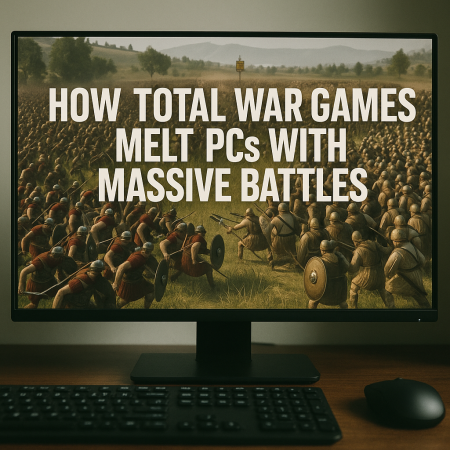There’s nothing quite like the sight of thousands of soldiers clashing in perfect formation. Cavalry charges, arrows blotting out the sun, and siege engines tearing down city walls—it’s the kind of cinematic warfare most games can only dream of. But if you’ve played the Total War series, you know those dreams come at a cost: your poor PC, sweating bullets as it tries to render the chaos of ancient, medieval, and modern warfare all at once.
When Strategy Meets Spectacle
Total War has always walked the line between brain-burning strategy and jaw-dropping visuals. On the one hand, you’re planning intricate empire-wide campaigns: diplomacy, trade, and resource management. On the other hand, you’re commanding real-time battles with tens of thousands of units on-screen at once. It’s this combination that makes the series unique—and also one of the most demanding in PC gaming.
Players often ask whether their setup can handle these clashes, and it usually comes down to the graphics card. The sheer scale of Total War makes a reliable powerhouse like an AMD GPU an appealing choice, since it needs to process huge draw distances, particle effects, and complex animations without turning your battlefield into a slideshow.
Why Total War Pushes Hardware to the Brink
Most games give your PC some breathing room. You’re often locked in corridors, small arenas, or controlled environments. Not Total War. The series says: “Here’s a 5,000-strong army. Here’s another one. Watch them fight—down to the individual sword swings.”
Every soldier has AI. Every horse kicks up dust. Every trebuchet launches physics-driven projectiles that impact hundreds of enemies. Multiply that by dozens of units across sprawling environments, and suddenly you’re asking your PC to juggle calculations on a massive scale in real time. It’s less about the number of polygons and more about sheer complexity.

The Optimization Battlefield
Not every Total War game is equally punishing. Total War: Shogun 2 still holds up beautifully without frying GPUs, while Total War: Warhammer III can leave even modern rigs gasping when the demons of Chaos swarm the battlefield. Each entry pushes the engine further, introducing bigger armies, flashier spell effects, and larger campaign maps.
This has led to Total War being unofficially used as a benchmark. When a new card drops, enthusiasts fire up the latest Total War to see how many frames it can sustain during a 20,000-unit clash. It’s not just about performance—it’s about survival.
The Player’s Arms Race
Here’s the kicker: Total War isn’t a series you play casually. If you’re commanding an empire, you want smooth frame rates when zooming in on your troops, not stuttering animations as your cavalry charge lands. That’s why many players upgrade their rigs with strategy games in mind. A solid CPU handles AI calculations, but a strong GPU ensures the battlefield feels alive rather than choppy.
For fans of AMD, the latest GPUs provide the horsepower to keep massive unit counts fluid while offering modern features like ray tracing and smart memory access. And let’s be honest: when you’re orchestrating the downfall of empires, you don’t want lag ruining your moment of glory.

Why It’s Worth the Strain
At the end of the day, Total War’s intensity is exactly what makes it unforgettable. Other games may give you tactical control or cinematic scale, but rarely both. Watching a grand strategy unfold, then zooming in to see the clash of steel and fury—it’s what keeps players coming back, even if their rigs cry for mercy.

